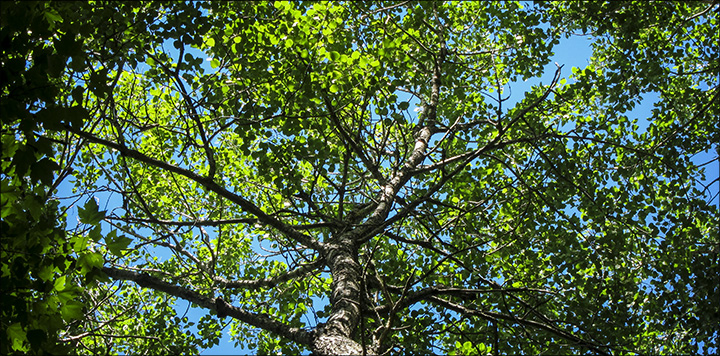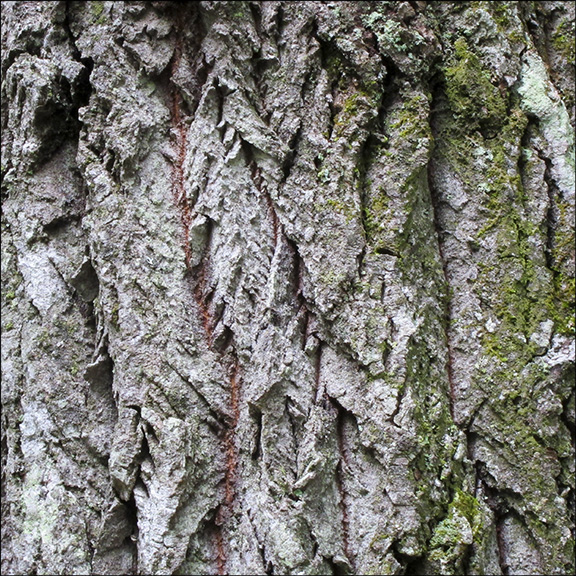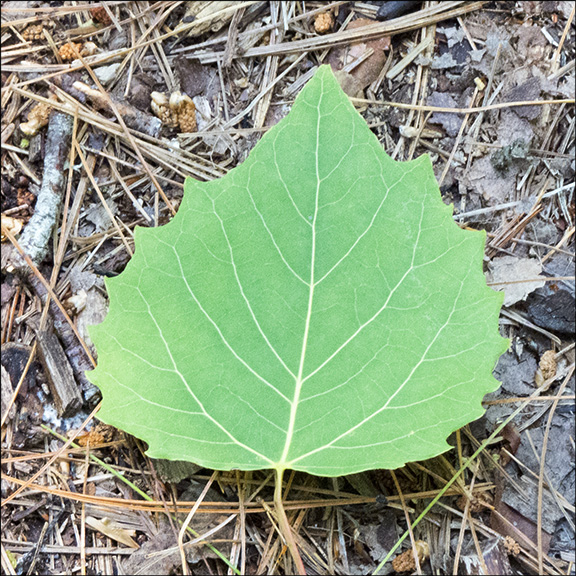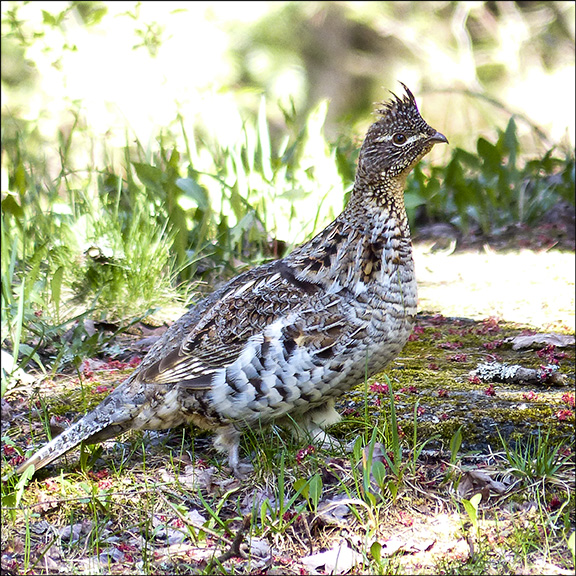Trees of the Adirondacks:
Bigtooth Aspen (Populus grandidentata)
 Trees of the Adirondacks: The upper trunk and branches of Bigtooth Aspen retain smooth, light-colored bark. Bigtooth Aspen at the VIC (28 July 2012).
Trees of the Adirondacks: The upper trunk and branches of Bigtooth Aspen retain smooth, light-colored bark. Bigtooth Aspen at the VIC (28 July 2012).| This page is no longer being updated. For an updated and expanded version of this material, see: Bigtooth Aspen (Populusgrandidentata). |
Bigtooth Aspen (Populus grandidentata) is a native deciduous tree, which grows throughout northeastern North America, including New York State and the Adirondack Mountains. It is also known as Largetooth Aspen, Poplar, or Popple. It is a member of the Willow family. A fast-growing, but short-lived, pioneer species, Bigtooth Aspen attains heights of 60 to 80 feet.

Identification of the Bigtooth Aspen: Bigtooth Aspen flowers appear in April or May (depending on temperature) in drooping catkins. The seeds mature in May or June. The tiny, white, wind-borne seeds disperse before the leaves are fully expanded. Good seed crops are produced every 2 or 3 years, but light seed crops are produced annually. Bigtooth Aspen flowers and disperses seeds about one to three weeks later than Quaking Aspen in the same location.
The buds of the Bigtooth Aspen, which are covered by whitish down, open the latest of all native trees in our part of the Adirondacks. Bigtooth leaves generally emerge the first week in June. The oval leaves are simple, alternate, with a short-pointed tip and a rounded base. When they first open in the spring, they are covered by dense whitish hairs, so the trees are very easy to identify at that time. Bigtooth Aspen leaves tremble in the slightest breeze and rustle loudly in wind. In the autumn, the leaves turn golden-yellow.
As with many species, the bark appearance of Bigtooth Aspen changes with age.
- Young Bigtooth Aspen trees have light, smooth bark, tan to yellow-ish or greenish gray. The bark often has an orange cast.
- The bark of a mature Bigtooth Aspen is darker and furrowed, often showing an orangish inner bar.
- As the tree ages further, the bark darkens further, and the furrows deepen. However, the upper trunk and branches retain a smooth and light-colored bark.

Leaf shape is key to distinguishing Bigtooth Aspens from other deciduous trees.
- Bigtooth Aspen leaves are oval, contrasting with the lobed leaves of Sugar Maple, Red Maple, and Striped Maple
- The large, rounded, irregular teeth on the Bigtooth Aspen contrasts with the sharply-toothed leaves of American Beech, Paper Birch, Yellow Birch, and Black Cherry.
Keys to differentiating Bigtooth Aspen from Quaking Aspen include its leaves, bark, and growth habit.
- The leaves of both species tremble in the breeze and are very similar in shape, with rounded teeth. However, the leaves of the Bigtooth Aspen are larger than those of Quaking Aspen and have much larger teeth. Bigtooth Aspen leaves emerge from the bud about ten days later than those of the Quaking Aspen.
- The Bigtooth Aspen is significantly larger than Quaking Aspen. Quaking Aspen trees rarely exceed 20" in diameter, while Bigtooth Aspen may reach 30".
- The bark of young Bigtooth Aspen trees is darker than that of Quaking Aspen. Moreover, the dark bark of mature Bigtooth Aspen contrasts with that of the mature Quaking Aspen, which features blackish furrows and much lighter-colored ridges.
Uses of the Bigtooth Aspen: Bigtooth Aspen wood is light-colored, straight-grained, finely-textured, and soft. It is primarily used for pulp. The wood is also used to make particle board and structural panels. Minor uses include log homes, pallets, boxes, match splints, chopsticks, hockey stick components, and ladders. Bigtooth Aspen bark is pelletized for fuel and supplemental cattle feed.
Bigtooth Aspen has a very limited number of edible uses. The inner bark reportedly can be dried, ground into a powder, and used as a thickener in soups. Medicinal uses of Bigtooth Aspen are also limited. Native Americans have reportedly used the bark for treating rheumatism and fevers. The Iroquois are said to have used dust from the bark to relieve itching.

Wildlife Value of the Bigtooth Aspen: Bigtooth Aspen provides both food and cover for wildlife. Aspen suckers are a favored winter food of Moose and are heavily browsed by White-tailed Deer. American Beaver eat the bark, leaves, twigs, and branches, and use the branches as construction material for lodges and dams. Cottontail Rabbit and Meadow Vole gnaw on the bark of saplings during the winter. Bigtooth Aspen buds are also eaten by the Fox Squirrel and Red Squirrel. The latter also uses the cavities (which form as the tree grows older) as dens.
Bigtooth Aspen is a host to many kinds of insects. The tree is a caterpillar host for the Canadian Tiger Swallowtail, White Admiral, and Modest Sphinx. The caterpillars of the Virgin Moth and other moths also feed on these trees.
Bigtooth Aspen trees are present in the breeding habitat for many birds, including Veery, Mourning Warbler, Black-and-white Warbler, Golden-winged Warbler, Nashville Warbler, Canada Warbler, Red-breasted Nuthatch, Red-eyed Vireo, and Philadelphia Vireo. As a Bigtooth Aspen tree becomes older, it often forms cavities that are used as nest sites by the Red-breasted Nuthatch, owls, and woodpeckers.
The Bigtooth Aspen is particularly important to the Ruffed Grouse. Aspen provides the basic habitat for this bird over much of its range. Ruffed Grouse feed on the leaves in the summer, flower buds in the winter, and catkins prior to the breeding season. The trees also provide crucial cover.
Range and Habitat of the Bigtooth Aspen: Bigtooth Aspen primarily occurs in the northeastern United States, southeastern Canada, and the Great Lakes Region. Its range extends from Virginia north to Maine and Cape Breton Island, Nova Scotia; west to southeastern Manitoba and Minnesota; south through Iowa to extreme northeastern Missouri; and east through Illinois, Indiana, Ohio, and West Virginia. In New York State, Bigtooth Aspen grows throughout the eastern portion of the state, including in the Adirondack Mountains.
Bigtooth Aspen is a pioneer tree after fires and logging; it can also be found on abandoned fields. Preferred habitats include most stream banks and upland woods. While capable of growing on a wide range of sites, Bigtooth Aspen is far less adaptable than Quaking Aspen. Bigtooth Aspen usually grows in mixed stands, most commonly with Quaking Aspen. Bigtooth Aspen is classed as very intolerant of shade. It cannot successfully reproduce under its own shade.
Bigtooth Aspen at the Paul Smiths VIC: Look for Bigtooth Aspen along many of the trails at the VIC, growing as individual trees in mixed stands, near Striped Maple, American Beech, and Sugar Maple. The most convenient place to observe the Bigtooth Aspen and compare this tree with other deciduous trees at the VIC is on the Barnum Brook Trail. This species is one of the eleven tree species marked with signage along this trail. The identified Bigtooth Aspen tree is less than a quarter of a mile from the entrance gazebo. If you take the left-hand fork and walk the trail in a clockwise direction, the tree is on the right hand side of the trail, just before the Striped Maple on your left.
References
- United States Department of Agriculture. Forest Service. Silvics of North America. Bigtooth Aspen. Retrieved 19 April 2016.
- United States Department of Agriculture. Forest Service. Fire Effects Information System (FEIS). Populus grandidentata. Retrieved 19 April 2016.
- United States Department of Agriculture. Plants Database. Retrieved 19 April 2016.
- Lady Bird Johnson Wildflower Center. Native Plant Database. Retrieved 19 April 2016.
- University of Wisconsin. Trees of Wisconsin. Populus grandidentata. Retrieved 19 April 2016.
- Online Encyclopedia of Life. Populus grandidentata. Retrieved 21 April 2016.
- University of Wisconsin. Flora of Wisconsin. Retrieved 19 April 2016.
- New York Flora Association. New York Flora Atlas. Retrieved 19 April 2016.
- University of Michigan. Native American Ethnobotany. A Database of Foods, Drugs, Dyes and Fibers of Native American Peoples, Derived from Plants. Retrieved 19 April 2016.
- Plants for a Future. Database. Retrieved 19 April 2016.
- Illinois Wildflowers. Big-Tooth Aspen. Retrieved 19 April 2016.
- The Birds of North America. Golden-winged Warbler, Red-breasted Nuthatch, Mourning Warbler, Nashville Warbler, Red-eyed Vireo, Black-and-White Warbler, Canada Warbler, Ruffed Grouse, Veery, and Philadelphia Vireo. Subscription Web Site. Retrieved 21 April 2016.
- Butterflies and Moths of North America. Canadian Tiger Swallowtail, White Admiral, Modest Sphinx. Retrieved 19 April 2016.
- Paul E. Slabaugh. Silvical Characteristics of Bigtooth Aspen (Populus grandidentata). (United States Department of Agriculture. Forest Service, 1958). Retrieved 21 April 2016.
- Gordon W. Gullion and Franklin J. Svoboda. "The Basic Habitat Resource for Ruffed Grouse," Aspen. Symposium Proceedings (USDA Forest Service, 1985), pp. 113-119.
- E.H. Ketchledge. Forests and Trees of the Adirondacks High Peaks Region (Lake George, New York: Adirondack Mountain Club, 1996), pp. 99-101.
- Michael Kudish. Adirondack Upland Flora. An Ecological Perspective (Saranac, New York: The Chauncy Press, 1992), pp. 136, 248.
- Michael Wojtech. Bark: A Field Guide to Trees of the Northeast (University Press of New England, 2011), pp. 226-229.
- William K. Chapman and Alan E. Bessette. Trees and Shrubs of the Adirondacks. A Field Guide (Utica, New York: North Country Books, Inc., 1990), p. 25, 54.
- Stan Tekiela. Trees of New York. Field Guide. (Cambridge, Minnesota: Adventure Publications, Inc., 2006), pp. 60-61.
- Peter J. Marchand. Nature Guide to the Northern Forest. Exploring the Ecology of the Forests of New York, New Hampshire, Vermont, and Maine (Boston, Massachusetts: Appalachian Mountain Club Books, 2010), p. 17.
- George A. Petrides. A Field Guide to Eastern Trees (Boston: Houghton Mifflin Company, 1998), pp.86-87, 277.
- George A. Petrides. A Field Guide to Trees and Shrubs (Boston: Houghton Mifflin Company, 1958,1972), pp. 211,322-323.
- Gil Nelson, Christopher J. Earle, and Richard Spellenberg. Trees of Eastern North America (Princeton : Princeton University Press, 2014), pp. 592-593.
- C. Frank Brockman. Trees of North America (New York: St. Martin's Press), pp. 88-89.
- National Audubon Society. Field Guide to North American Trees. Eastern Region (New York: Alfred A. Knopf, 1980, 1995), Plates 191, 599; pp. 323-324.
- Alexander C. Martin, Herbert S. Zim, and Arnold L. Nelson. American Wildlife & Plants: A Guide to Wildlife Food Habits (New York: Dover Publications, 1951), pp. 300-301.
- Bruce Kershner, et al. National Wildlife Federation Field Guide to Trees of North America (New York: Sterling Publishing Co., 2008), p. 398.
- David Allen Sibley. The Sibley Guide to Trees (New York: Alfred A. Knopf, 2009), p. 231.
